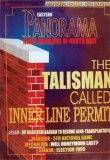Letter from the Editor-in-Chief
COMMENT
November 2012
Will ILP suffice?
 Recently the demand for introduction of Inner Line Permit (ILP) system has gained ground in Meghalaya. This is in fact not a new demand. This is precisely to regulate the flow of outsiders and prevent entry of illegal foreigners to the State.
Recently the demand for introduction of Inner Line Permit (ILP) system has gained ground in Meghalaya. This is in fact not a new demand. This is precisely to regulate the flow of outsiders and prevent entry of illegal foreigners to the State.
Now the question is being asked whether the ILP is a panacea to put a stop to the influx of foreign nationals.
To examine this issue a senior Journalist Sumar Sing Sawian wrote the cover story. This is the second time we have published a cover story on ILP, the earlier one was published in March 1999. In 1998, Government of Meghalaya constituted a working group with Mr. Paul Lyngdoh as the Secretary and Mr. Donkupar Roy as the Chairman. The working group at that time recommended for ILP in Meghalaya. Again in 1999, another working group was formed under the Chairmanship of Mr. T. H. Rangad. This group rejected the idea of ILP and suggested introduction of a three-tier identity card with 1971 as the cut off year, to determine the status of residents in the State. The card would be issued to permanent residents, semi-permanent residents and temporary residents. However, once again in 2012 exactly after 14 years, the Government of Meghalaya has formed a working group to study and recommend the measures to curb the menace of influx. Given the developments so far, the committee is likely to recommend for the ILP in Meghalaya. However, the implementation of ILP will require the nod from the Centre which has already turned down the demand of ILP from Manipur Government.
The Inner Line Permit System under the Bengal Eastern Frontier Regulations, 1873 was introduced long ago in Mizoram, Nagaland and Arunachal Pradesh. The aim was to ensure that ethnic tribes of these three states could maintain their distinct culture, identity and at the same time promote their culture and tradition.
 It is apprehended that the ILP will have an adverse impact on the flow of tourists coming to Meghalaya thereby affecting the economy of the state. This is true. But it is also a fact that unabated influx of foreign nationals particularly Bangladeshis need to be checked. It may be taken note of that ILP has failed to prevent influx of outsiders, illegal migrants to Mizoram, Nagaland and Arunachal Pradesh where the demography has changed considerably over the years.
It is apprehended that the ILP will have an adverse impact on the flow of tourists coming to Meghalaya thereby affecting the economy of the state. This is true. But it is also a fact that unabated influx of foreign nationals particularly Bangladeshis need to be checked. It may be taken note of that ILP has failed to prevent influx of outsiders, illegal migrants to Mizoram, Nagaland and Arunachal Pradesh where the demography has changed considerably over the years.
The idea of “Work Permit” sounds better and more effective than the ILP. Nobody can deny labourers from outside, as Mr. Sumar Sing Sawain has pointed out, are working at construction sites where locals are either not willing to work or are simply not available. Putting a hold on the developmental work for want of labourers is not a good idea.
An effective mechanism to control influx of foreign national is the need of the hour. We should also ensure that bonafied Indian citizens are not harassed. In the long run, it’s not the NGOs but the state administration which is responsible to check the influx of foreign nationals in the region. It is they who must act.
Dr. K. K. Jhunjhunwala
